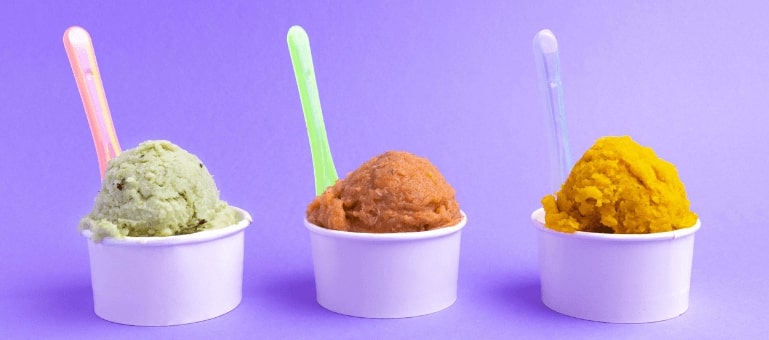Imagine strolling through the charming streets of Florence, Italy, where the sun casts a warm glow on centuries-old buildings.
You notice a line of eager tourists and locals waiting to taste Italy’s sweetest treasure – gelato. Originating from Italy, gelato is a creamy frozen dessert that has captured hearts worldwide.
But what is gelato exactly? Often confused with ice cream, gelato differs in several important ways. Exploring gelato introduces you to new flavors and gives you a taste of Italian culture.
Did you know the global gelato market has a CAGR of 6.6%? This shows how much people love and appreciate this delicious treat and hold and visit happening trade shows for gelato.
So, let’s dive into the gelato world and discover what makes it so unique!
What is Gelato?

Gelato is a traditional Italian ice cream that has been enjoyed for centuries. Its origins can be traced back to Italy, where it was first created during the Renaissance period.
Unlike other frozen desserts, gelato is known for its unique characteristics: denser, creamier, and more flavorful.
The primary ingredients in gelato are milk, sugar, and flavorings. One of the main differences between gelato and other frozen treats, like ice cream, is that gelato uses less cream and more milk. This lower fat content produces a lighter texture, making the flavors more prominent.
Traditional gelato recipes do not typically include eggs, often used in ice cream to create a custard base.
Gelato is also churned slower, introducing less air into the mixture. This gives it a denser and smoother texture than ice cream, which tends to be fluffier due to the incorporation of more air.
Additionally, gelato is served at slightly higher temperatures than ice cream, enhancing its creamy texture and melting the tongue more slowly.
Using simple, high-quality ingredients and traditional methods, gelato artisans create a treat rich in flavor and deeply rooted in Italian culture.
Production Process:
The traditional process of making gelato ice cream is an art that involves precise techniques to achieve its signature texture and flavor.
The process begins with mixing the primary gelato ingredients: milk, sugar, and flavorings. Unlike ice cream, which often includes heavy cream, gelato uses more milk and less cream, resulting in a lower fat content.
Churning Speed
One critical difference between gelato and ice cream is the churning speed. Gelato is churned at a slower speed, which introduces less air into the mixture—this process, known as overrun, results in a denser and creamier texture.
While ice cream can have an overrun of up to 50%, gelato typically has an overrun of 20-30%. This lower air content gives gelato its rich and smooth consistency, making each bite more flavorful.
Serving Temperature
Another distinctive feature of gelato is its serving temperature. Gelato is served at slightly higher temperatures than ice cream, usually between 10 to 15 degrees Fahrenheit (approximately -12 to -9 degrees Celsius).
This warmer temperature enhances its creamy texture and makes the flavors more immediate and pronounced. In contrast, ice cream is typically served at a colder temperature, around 6 to 10 degrees Fahrenheit (-14 to -12 degrees Celsius), which can make it firmer and less creamy.
Gelato vs. Ice Cream

While gelato and ice cream are both beloved frozen treats, several key differences set them apart. These differences influence their texture, flavor, and overall eating experience.
From the ingredients used to the churning process and serving temperature, understanding these distinctions can develop your appreciation of each dessert. Let’s look into what makes gelato vs ice cream a fascinating comparison.
| Features | Gelato | Ice Cream | |
|---|---|---|---|
| 1 | Ingredients | Milk, sugar, some cream, (optional) eggs | Milk, cream, sugar, egg yolks (usually) |
| 2 | Fat Content | Lower (typically 4-9%) | Higher (around 14-16%) |
| 3 | Air Content | Less air whipped in (denser) | More air incorporated (lighter) |
| 4 | Churning Speed | Slower churn (denser texture) | Faster churn (airier texture) |
| 5 | Serving Temperature | Slightly warmer (-14 to -11°C) | Colder (-18°C or below) |
| 6 | Texture | Denser, smoother, more elastic | Lighter, airier, fluffier |
| 7 | Taste | Intense, pure flavors | Can be rich, but flavors may be dulled by air |
1. Ingredients
One of the primary differences between gelato and ice cream is their ingredients. One of the main questions is always, what is gelato made of?
Gelato ingredients include more milk and less cream compared to ice cream, resulting in a lower fat content for gelato. Traditional Italian ice cream recipes also tend to avoid using egg yolks, which are commonly found in ice cream.
Ice cream typically contains more cream and egg yolks to create a rich custard base. This difference in ingredients is a critical factor contributing to the distinct textures and flavors of gelato and ice cream.
2. Fat Content
The fat content in gelato is significantly lower than in ice cream. Gelato usually contains about 4-9% fat, whereas ice cream can have a fat content of 14-25%. This lower fat content in gelato allows the flavors of the other ingredients to stand out more, making the taste more intense.
In contrast, ice cream’s higher fat content gives it a more prosperous and creamier texture but can sometimes mask the flavors of the added ingredients. The difference in fat content between gelato and ice cream plays a crucial role in how the palate perceives each dessert.
3. Air Content
Another notable difference between gelato and ice cream is the air whipped into each. Gelato has much less air, resulting in a denser and more substantial texture. This is achieved by churning gelato slower, minimizing air content.
On the other hand, ice cream is churned faster, introducing more air and making it lighter and fluffier. The reduced air content in gelato increases its creaminess. It allows for a more concentrated flavor experience, while the higher air content in ice cream gives it a softer and more airy texture.
4. Churning Speed
The churning speed is a crucial factor in differentiating gelato from ice cream. Gelato is churned at a slower speed, incorporating less air into the mixture and resulting in a denser texture.
This slow churning process is essential for creating the smooth and creamy consistency that gelato is known for.
In contrast, ice cream is churned faster, increasing the air in the mixture and giving it a lighter and fluffier texture. The difference in churning speed between ice cream and gelato significantly affects the mouthfeel and density of each dessert.
5. Serving Temperature
Another aspect that sets gelato apart from ice cream is the serving temperature. Gelato is typically served at a slightly higher temperature, around 10 to 15 degrees Fahrenheit (approximately -12 to -9 degrees Celsius).
This warmer temperature enhances its creamy texture and makes it melt more slowly in the mouth, making the flavors more pronounced.
In comparison, ice cream is served at a colder temperature, around 6 to 10 degrees Fahrenheit (-14 to -12 degrees Celsius), which makes it firmer and less creamy.
The difference between gelato and ice cream in serving temperature contributes to the overall eating experience, with gelato offering a softer and more flavorful bite.
6. Texture
One of gelato’s most defining features is its texture. Due to its lower fat content, slower churning speed, and reduced air incorporation, gelato has a denser and smoother texture than ice cream. With its higher fat content and faster churning speed, ice cream tends to be creamier and fluffier.
The difference in texture between ice cream and gelato results from the distinct production methods and ingredient proportions used for each dessert.
Gelato’s dense texture allows for a more intense and satisfying flavor experience, while ice cream’s lighter texture makes it feel more decadent and indulgent.
7. Taste
Finally, the taste of gelato cream is influenced by its lower fat content and higher serving temperature. Because gelato contains less fat, the flavors of the other ingredients are more pronounced and intense.
The slightly warmer serving temperature also helps to enhance the flavor perception, making gelato a more flavorful treat. In contrast, the higher fat content in ice cream can sometimes mute the flavors, but it also provides a rich and creamy mouthfeel that many people enjoy.
The difference in taste between ice cream and gelato is a key factor in why some people prefer one over the other, with gelato offering a more vibrant and direct flavor experience.
The Allure of Gelato

Gelato’s unique advantages, ingredients, and general taste make it a beloved dessert worldwide. Here are some key reasons why:
Intense and Authentic Flavors
- Less air and fat: Due to the lower air content and fat levels, gelato offers more pronounced and genuine flavors. This results from the slower churning process and reduced cream, allowing the ingredients to stand out.
- Flavor burst: When you taste gelato, you experience a burst of authentic flavors, making each bite a delightful experience.
Luxurious Texture
- Denser consistency: Gelato has a denser texture than ice cream because of its slower churning process. This creates a more luxurious mouthfeel that many find irresistible.
- Satisfying mouthfeel: Unlike ice cream, which sometimes feels light and airy, gelato’s dense and creamy consistency provides a rich and indulgent eating experience.
Health-Conscious Appeal
- Lower fat content: Gelato ice cream typically contains about 4-9% fat, whereas ice cream can have a fat content of 14-25%. This makes gelato a lighter option for those mindful of their fat intake.
- Guilt-free indulgence: The lower fat content not only heightens the intensity of the flavors but also makes gelato an appealing choice for health-conscious consumers. It lets you enjoy a delicious treat without the guilt of higher-fat desserts.
In summary, the allure of gelato lies in its intense and authentic flavors, luxurious texture, and lower fat content. These characteristics make gelato a preferred choice for many dessert lovers who seek a flavorful, satisfying, and health-conscious option.
What is Gelato (FAQs)
Is gelato healthier than ice cream?
Gelato often contains less fat and fewer calories than ice cream due to its higher milk-to-cream ratio and absence of egg yolks. This makes it a lighter, potentially healthier option for those watching their fat intake.
Is gelato dairy-free?
Traditional gelato is made with milk and is not dairy-free. However, many gelaterias offer dairy-free options with alternatives like almond milk, soy milk, or coconut milk to cater to those with lactose intolerance or dietary preferences.
Conclusion
Gelato is a traditional Italian ice cream known for its intense flavors, dense texture, and lower fat content. The difference between gelato and ice cream lies in the ingredients, churning speed, air content, and serving temperature.
Gelato’s luxurious mouthfeel and authentic flavors make it a delightful treat that offers a taste of Italian culture. Its lower fat content appeals to health-conscious consumers, providing a guilt-free indulgence.
Whether you prefer the rich, airy texture of ice cream or gelato’s dense, creamy consistency, understanding these differences adds to the enjoyment of both desserts.
So, next time you crave a frozen treat, consider savoring a scoop of gelato ice cream and experience its unique allure.








